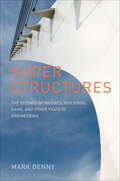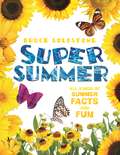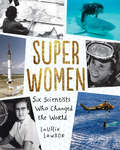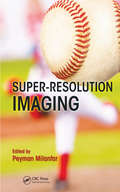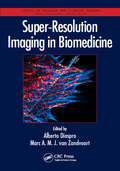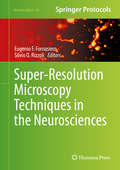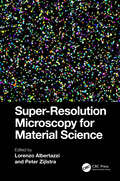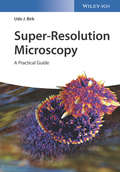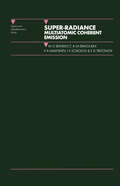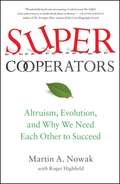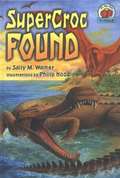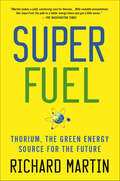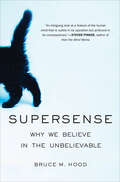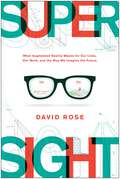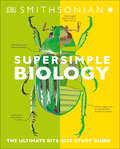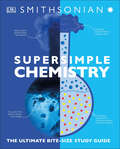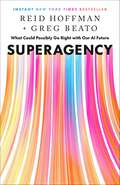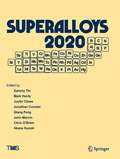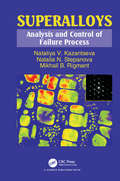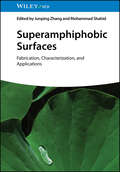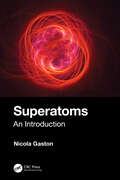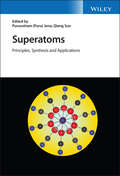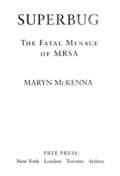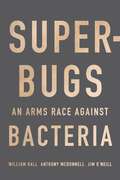- Table View
- List View
Super Structures: The Science of Bridges, Buildings, Dams, and Other Feats of Engineering
by Mark DennyAn “extraordinary guide to the hidden secrets of modern man-made miracles . . . Highly recommended” —from the author of Froth!: The Science of Beer (Midwest Book Review).Ever wonder how a graceful and slender bridge can support enormous loads over truly astonishing spans? Why domes and free-standing arches survive earthquakes that flatten the rest of a city?Physicist Mark Denny looks at the large structures around us—tall buildings, long bridges, and big dams—and explains how they were designed and built and why they sometimes collapse, topple, or burst.Denny uses clear, accessible language to explain the physics behind such iconic structures as the Parthenon, the Eiffel Tower, the Forth Rail Bridge in Edinburgh, and Hoover Dam. His friendly approach allows readers to appreciate the core principles that keep these engineering marvels upright without having to master complex mathematical equations.Employing history, humor, and simple physics to consider such topics as when to use screws or nails, what trusses are, why iron beams are often I-shaped, and why medieval cathedrals have buttresses, Denny succeeds once again in making physics fun.Praise for Mark Denny“Denny’s wry humor is fun to read and made me laugh out loud.” —Mark Kidger, author of Astronomical Enigmas“Denny largely sheds the complexity of mathematical constructs, distilling their most salient features into a more qualitative understanding of radar and sonar systems.” —Choice“Indeed, Denny’s writing is anything but dry and boring. He adeptly explains complex subject matter and does so with relatively simple language and minimal use of symbolic notation.” —Bat Research News
Super Summer: All Kinds of Summer Facts and Fun (Season Facts and Fun)
by Bruce GoldstoneSummer is a season of plenty—plenty of sun and fun. People take vacations and find plenty of activities in and around water. Animals try to stay cool, while bees and wasps go to work. Flowers bloom and fruits and vegetables ripen. Get ready to explore summer's amazing abundance!With vivid photographs, lively explanations, and creative craft ideas, Bruce Goldstone's Super Summer presents all the fascinating facts that make summer so super in his fourth and final picture book about the seasons.
Super Women: Six Scientists Who Changed the World
by Laurie Lawlor"Inspiring profiles of six 20th-century trailblazers."—Kirkus ReviewsSuper Women celebrates the scientific as well as the social significance of six incredible women who broke new ground with their research, busted through glass ceilings with their careers, and advanced humanity's understanding of our world in the process. These amazing women defied prejudice to succeed in the sciences using genius, ambition, and perseverance:Katherine Coleman Johnson, a mathematician who calculated trajectories for NASA flights and is one of the women showcased in the award-winning feature film, Hidden FiguresEugenie Clark, an ichthyologist who swam with sharksMarie Tharp, a cartographer who mapped the ocean floorFlorence Hawley Ellis, an anthropologist of Pueblo cultures who pioneered tree-ring datingGertrude Elion, a Noble Prize-winning pharmacologist who developed treatments for leukemia and AIDSMargaret Burbidge, an astrophysicist who formulated a theory of quasars and helped create the Hubble telescopeALA Notable Book author Laurie Lawlor deftly paints portraits of each of these pioneers who refused to take no for an answer, pursuing their passions through fieldwork, observations, laboratories, and research vessels in the face of sexism. This diverse group of women, all with awe-inspiring accomplishments, were active mentors and determined people who wouldn’t take no for an answer.The beautifully written book includes key photographs, a glossary, and source notes—and is truly an important book for our time.A 2018 NSTA-CBC Outstanding Science Trade Book for Students K-12!
Super-Food für Wissenshungrige!: Warum wir essen, was wir essen
by Kathrin BurgerVeganismus, Steinzeitkost, Clean Eating – Spezial-Diäten sind beliebt. Ob sie auch gesund sind, erfahren sie in diesem Buch, einer Sammlung aus 27 allgemein verständlichen Beiträgen aus Spektrum der Wissenschaft und spektrum.de . Klar ist, dass nicht zu viele stark verarbeitete Fertigprodukte auf dem Tisch stehen sollten. Doch Ernährung ist viel mehr als die Summe der Inhaltsstoffe in den verzehrten Lebensmitteln. Essen ist ein „kulturelles Totalphänomen“. Das heißt, es spielen psychische sowie gesellschaftliche Faktoren eine große Rolle dabei, was wir essen. Darum essen Männer auch etwas anderes als Frauen, darum unterscheiden sich Speisepläne auf der ganzen Welt und darum werden Ess-Entscheidungen großteils nicht mit dem Verstand sondern mit dem Gefühl getroffen. Genießen Sie also die hier aufgetischten Fakten und stillen Sie Ihren Wissenshunger.
Super-Resolution Imaging (Digital Imaging and Computer Vision)
by Peyman MilanfarWith the exponential increase in computing power and broad proliferation of digital cameras, super-resolution imaging is poised to become the next "killer app." The growing interest in this technology has manifested itself in an explosion of literature on the subject. Super-Resolution Imaging consolidates key recent research contributions from eminent scholars and practitioners in this area and serves as a starting point for exploration into the state of the art in the field. It describes the latest in both theoretical and practical aspects of direct relevance to academia and industry, providing a base of understanding for future progress. Features downloadable tools to supplement material found in the book Recent advances in camera sensor technology have led to an increasingly larger number of pixels being crammed into ever-smaller spaces. This has resulted in an overall decline in the visual quality of recorded content, necessitating improvement of images through the use of post-processing. Providing a snapshot of the cutting edge in super-resolution imaging, this book focuses on methods and techniques to improve images and video beyond the capabilities of the sensors that acquired them. It covers: History and future directions of super-resolution imaging Locally adaptive processing methods versus globally optimal methods Modern techniques for motion estimation How to integrate robustness Bayesian statistical approaches Learning-based methods Applications in remote sensing and medicine Practical implementations and commercial products based on super-resolution The book concludes by concentrating on multidisciplinary applications of super-resolution for a variety of fields. It covers a wide range of super-resolution imaging implementation techniques, including variational, feature-based, multi-channel, learning-based, locally adaptive, and nonparametric methods. This versatile book can be used as the basis for short courses for engineers and scientists, or as part of graduate-level courses in image processing.
Super-Resolution Imaging in Biomedicine (Series in Cellular and Clinical Imaging)
by Alberto Diaspro and Marc A. M. J. van ZandvoortThis book encompasses the full breadth of the super-resolution imaging field, representing modern techniques that exceed the traditional diffraction limit, thereby opening up new applications in biomedicine. It shows readers how to use the new tools to increase resolution in sub-nanometer-scale images of living cells and tissue, which leads to new information about molecules, pathways and dynamics. The book highlights the advantages and disadvantages of the techniques, and gives state-of-the-art examples of applications using microscopes currently available on the market. It covers key techniques such as stimulated emission depletion (STED), structured illumination microscopy (SSIM), photoactivated localization microscopy (PALM), and stochastic optical reconstruction microscopy (STORM). It will be a useful reference for biomedical researchers who want to work with super-resolution imaging, learn the proper technique for their application, and simultaneously obtain a solid footing in other techniques.
Super-Resolution Microscopy Techniques in the Neurosciences
by Eugenio F. Fornasiero Silvio O. RizzoliSuper-Resolution Microscopy Techniques in the Neurosciences serves as a comprehensive description of current super-resolution techniques, including the physical principles that allowed for their development, some of the most recent neurobiological applications and selected information for the practical use of these technologies. Written for the Neuromethods series, this detailed work contains contributions from experts in the field and provides key implementation advice to ensure successful results in the lab. Authoritative and cutting-edge, Super-Resolution Microscopy Techniques in the Neurosciences is an ideal guide for researchers aiming to continue increasing the resolution in the imaging capabilities of neuroscientists and thereby changing the perspective in which cellular biology processes are understood at the nanometer scale.
Super-Resolution Microscopy for Material Science
by Lorenzo Albertazzi Peter ZijlstraOptical microscopy is one of the most frequently used tools in chemistry and the life sciences. However, its limited resolution hampers the use of optical imaging to many other relevant problems in different disciplines. Super-Resolution Microscopy (SRM) is a new technique that allows the resolution of objects down to a few billionth of meters (nanometers), ten times better than classical microscopes, opening up opportunities to use this tool in new fields.This book describes the theory, principles, and practice of super-resolution microscopy in the field of materials science and nanotechnology. There is a growing interest in the applications of SRM beyond biology as new synthetic materials, such as nanoscale sensors and catalysts, nanostructured materials, functional polymers, and nanoparticles, have nanoscopic features that are challenging to visualize with traditional imaging methods.SRM has the potential to be used to image and understand these cutting-edge man-made objects and guide the design of materials for novel applications.This book is an ideal guide for researchers in the fields of microscopy and materials science and chemistry as well as graduate students studying physics, materials science, biomedical engineering, and chemistry.Key Features: Contains practical guidance on Super-Resolution Microscopy (SRM), an exciting and growing tool that was awarded the Nobel Prize for chemistry in 2014 Provides a new perspective targeting materials science, unlike existing books which target readers in chemistry, life science, and biology Targets students in its core chapters, while offering more advanced material for professionals and researchers in later chapters
Super-Resolution Microscopy: A Practical Guide
by Udo J. BirkThis unique book on super-resolution microscopy techniques presents comparative, in-depth analyses of the strengths and weaknesses of the individual approaches. It was written for non-experts who need to understand the principles of super-resolution or who wish to use recently commercialized instruments as well as for professionals who plan to realize novel microscopic devices. Explaining the practical requirements in terms of hardware, software and sample preparation, the book offers a wealth of hands-on tips and practical tricks to get a setup running, provides invaluable help and support for successful data acquisition and specific advice in the context of data analysis and visualization. Furthermore, it addresses a wide array of transdisciplinary fields of applications. The author begins by outlining the joint efforts that have led to achieving super-resolution microscopy combining advances in single-molecule photo-physics, fluorophore design and fluorescent labeling, instrument design and software development. The following chapters depict and compare current main standard techniques such as structured illumination microscopy, single-molecule localization, stimulated emission depletion microscopy and multi-scale imaging including light-sheet and expansion microscopy. For each individual approach the experimental setups are introduced, the imaging protocols are provided and the various applications illustrated. The book concludes with a discussion of future challenges addressing issues of routine applications and further commercialization of the available methods. Guiding users in how to make choices for the design of their own experiments from scratch to promising application, this one-stop resource is intended for researchers in the applied sciences, from chemistry to biology and medicine to physics and engineering.
Super-radiance: Multiatomic Coherent Emission (Series In Optics And Optoelectronics Ser.)
by M G Benedict A M Ermolaev V A Malyshev I V Sokolov E D TrifonovSuper-radiance: Multiatomic Coherent Emission provides a comprehensive, self-contained account of the theory and experiments of the quantum optic phenomenon of superradiance. Contributed by highly regarded researchers in the field, the book first presents the theory of superradiance at a level suitable for graduate physicists approaching the subject for the first time. This introduction is followed by a more rigorous treatment that is supported by the analysis of experiments dealing with superradiance and by a discussion on the possible uses of the effect in other areas of optics and electronics. The theoretical and experimental results presented in this book will introduce a wide audience to this important area of quantum optics.
SuperCooperators
by Roger Highfield Martin NowakEVOLUTION IS OFTEN PRESENTED AS A STRICTLY COMPETITIVE ENDEAVOR. This point of view has had serious implications for the way we see the mechanics of both science and culture. But scientists have long wondered how societies could have evolved without some measure of cooperation. And if there was cooperation involved, how could it have arisen from nature "red in tooth and claw"? Martin Nowak, one of the world's experts on evolution and game theory, working here with bestselling science writer Roger Highfield, turns an important aspect of evolutionary theory on its head to explain why cooperation, not competition, has always been the key to the evolution of complexity. He offers a new explanation for the origin of life and a new theory for the origins of language, biology's second greatest information revolution after the emergence of genes. SuperCooperators also brings to light his game-changing work on disease. Cancer is fundamentally a failure of the body's cells to cooperate, Nowak has discovered, but organs are cleverly designed to foster cooperation, and he explains how this new understanding can be used in novel cancer treatments. Nowak and Highfield examine the phenomena of reciprocity, reputation, and reward, explaining how selfless behavior arises naturally from competition; how forgiveness, generosity, and kindness have a mathematical rationale; how companies can be better designed to promote cooperation; and how there is remarkable overlap between the recipe for cooperation that arises from quantitative analysis and the codes of conduct seen in major religions, such as the Golden Rule. In his first book written for a wide audience, this hugely influential scientist explains his cutting-edge research into the mysteries of cooperation, from the rise of multicellular life to Good Samaritans. With wit and clarity, Nowak and Highfield make the case that cooperation, not competition, is the defining human trait. SuperCooperators will expand our understanding of evolution and provoke debate for years to come.
SuperCroc Found
by Sally M. WalkerChildren's book about the discovery of a crocodile fossil from prehistoric times.
SuperFuel: Thorium, the Green Energy Source for the Future (MacSci)
by Richard MartinA riveting look at how an alternative source of energy is revoluntionising nuclear power, promising a safe and clean future for millions, and why thorium was sidelined at the height of the Cold War In this groundbreaking account of an energy revolution in the making, award-winning science writer Richard Martin introduces us to thorium, a radioactive element and alternative nuclear fuel that is far safer, cleaner, and more abundant than uranium. At the dawn of the Atomic Age, thorium and uranium seemed to be in close competition as the fuel of the future. Uranium, with its ability to undergo fission and produce explosive material for atomic weapons, won out over its more pacific sister element, relegating thorium to the dustbin of science. Now, as we grapple with the perils of nuclear energy and rogue atomic weapons, and mankind confronts the specter of global climate change, thorium is re-emerging as the overlooked energy source as a small group of activists and outsiders is working, with the help of Silicon Valley investors, to build a thorium-power industry. In the first book mainstream book to tackle these issues, Superfuel is a story of rediscovery of a long lost technology that has the power to transform the world's future, and the story of the pacifists, who were sidelined in favour of atomic weapon hawks, but who can wean us off our fossil-fuel addiction and avert the risk of nuclear meltdown for ever.
SuperSense: Why We Believe in the Unbelievable
by Bruce M. HoodA neuroscientist examines the science behind humanity’s beliefs in the supernatural.The majority of the world’s population is religious or believes in supernatural phenomena. In the United States, nine out of every ten adults believe in God, and a recent Gallup poll found that about three out of four Americans believe in some form of telepathy, déjà vu, ghosts, or past lives. Where does such supernatural thinking come from? Are we indoctrinated by our parents, churches, and media, or do such beliefs originate somewhere else? In SuperSense, award-winning cognitive scientist Bruce M. Hood reveals the science behind our beliefs in the supernatural.Superstitions are common. Many of us cross our fingers, knock on wood, step around black cats, and avoid walking under ladders. John McEnroe refused to step on the white lines of a tennis court between points. Wade Boggs insisted on eating a chicken dinner before every Boston Red Sox game. President Barack Obama played a game of basketball the morning of his victory in the Iowa primary and continued the tradition on every subsequent election day.Supernatural thinking includes loftier beliefs as well, such as the sentimental value we place on photos of loved ones, wedding rings, and teddy bears. It also includes spiritual beliefs and the hope for an afterlife. But in this modern, scientific age, why do we hold on to these behaviors and beliefs?It turns out that belief in things beyond what is rational or natural is common to humans and appears very early in childhood. In fact, according to Hood, this “super sense” is something we're born with to develop and is essential to the way we learn to understand the world. We couldn’t live without it!Our minds are designed from the very start to think there are unseen patterns, forces, and essences inhabiting the world, and it is unlikely that any effort to get rid of supernatural beliefs, or the superstitious behaviors that accompany them, will be successful. These common beliefs and sacred values are essential in binding us together as a society because they help us to see ourselves connected to each other at a deeper level.
SuperSight: What Augmented Reality Means for Our Lives, Our Work, and the Way We Imagine the Future
by David RoseNATIONAL INDIE EXCELLENCE AWARDS WINNER — NONFICTION 2022 IPPY AWARDS BRONZE MEDALIST — SCIENCE For thousands of years, human vision has been largely unchanged by evolution. We&’re about to get a software update. Today, Apple, Google, Microsoft, Facebook, Snap, Samsung, and a host of startups are racing to radically change the way we see. The building blocks are already falling into place: cloud computing and 5G networks, AI computer vision algorithms, smart glasses and VR headsets, and mixed reality games like Pokémon GO. But what&’s coming next is a fundamental shift in how we experience the world and interact with each other. Over the next decade, what we see and how we see it will no longer be bound by biology. Instead, our everyday vision will be augmented with digital information to give us what spatial computing pioneer David Rose calls &“SuperSight.&” And as our view of the world becomes blended layers of information delivered via glasses, contact lenses, or projected light, it will fundamentally change learning, shopping, work, play, and much, much more. David provides an insider&’s guide to the way our lives are about to change, while also unpacking the downsides of this coming world—what he calls the hazards of SuperSight, from equity and access issues to bubble filter problems—and proposing rational, actionable ways around them. From AI mirrors that advise us on our outfits, to museums that let us talk with deceased explorers and artists, to the ways we envision sustainable cities, the scope of augmented vision is boundless. SuperSight offers a rich speculative preview of the future and its implications, both shocking and thrilling.
SuperSimple Biology: The Ultimate Bitesize Study Guide (DK Super Simple)
by DKA fantastic aid for coursework, homework, and test revision, this is the ultimate study guide to biology.From reproduction to respiration and from enzymes to ecosystems, every topic is fully illustrated to support the information, make the facts clear, and bring biology to life. For key ideas, &“How it works&” and &“Look closer&” boxes explain the theory with the help of simple graphics. And for revision, a handy &“Key facts&” box provides a summary you can check back on later. With clear, concise coverage of all the core biology topics, SuperSimple Biology is the perfect accessible guide for students, supporting classwork, and making studying for exams the easiest it&’s ever been.
SuperSimple Chemistry: The Ultimate Bitesize Study Guide (DK Super Simple)
by DKA fantastic aid for coursework, homework, and studying for tests, this comprehensive guide covers Next Generation Science Standards, for grades 6-10 and will have you ready for tests and exams in no time. Each topic is fully illustrated to support the information, make the facts crystal clear, and bring the science to life. A large central image explains the idea visually and each topic is summed up on a single page, helping children to quickly get up to speed and really understand how chemistry works.Information boxes explain the theory with the help of simple graphics and for further studying, a handy &“Key Facts&” box provides a simple summary you can check back on later.With clear, concise coverage of all the core topics, SuperSimple Chemistry is the perfect accessible guide to chemistry for children, supporting classwork, and making studying for exams the easiest it&’s ever been.
Superagency: What Could Possibly Go Right with Our AI Future
by Reid Hoffman Greg BeatoInstant New York Times and USA Today Bestseller. Tech visionary and co-founder of Manas AI Reid Hoffman shares his unique insider’s perspective on an AI-powered future, making the case for its potential to unlock a world of possibilities. <p> "An essential companion." — Fei-Fei Li <p> "An important read." —Bill Gates <p> "Brilliant mind. Compassionate heart. Bold ideas…Read this book!” —Van Jones <p> "Refreshingly optimistic and welcome perspective." — Ariana Huffington <p> "A fascinating and insightful book." —Yuval Noah Harari <p> As taught at UPenn's Wharton and Stanford. Superagency offers a roadmap for using AI inclusively and adaptively to improve our lives and create positive change. While acknowledging challenges like disinformation and potential job changes, the book focuses on AI’s immense potential to increase individual agency and create better outcomes for society as a whole. Imagine AI tutors personalizing education for each child, researchers rapidly discovering cures for diseases like Alzheimer's and cancer, and AI advisors empowering people to navigate complex systems and achieve their goals. Hoffman and co-author, tech and culture writer Greg Beato envision a world where these possibilities, and many more, become a reality. <p> Superagency challenges conventional fears, inviting us to view the future through a lens of opportunity, rather than fear. It’s a call to action – to embrace AI with excitement and actively shape a world where human ingenuity and the power of AI combine to create something extraordinary. Entrepreneur Reid Hoffman is a co-founder of LinkedIn, Inflection AI, and Manas AI. He is also host of the podcasts Possible and Masters of Scale. <b>New York Times Bestseller</b>
Superalloys 2020: Proceedings of the 14th International Symposium on Superalloys (The Minerals, Metals & Materials Series)
by Chris O'Brien Mark Hardy Sammy Tin Justin Clews Jonathan Cormier Qiang Feng John Marcin Akane SuzukiThe 14th International Symposium on Superalloys (Superalloys 2020) highlights technologies for lifecycle improvement of superalloys. In addition to the traditional focus areas of alloy development, processing, mechanical behavior, coatings, and environmental effects, this volume includes contributions from academia, supply chain, and product-user members of the superalloy community that highlight technologies that contribute to improving manufacturability, affordability, life prediction, and performance of superalloys.
Superalloys: Analysis and Control of Failure Process
by Nataliya V. Kazantseva Natalia N. Stepanova Mikhail B. RigmantSuperalloys form a class of the structural materials for high-temperature applications. Nickel superalloys are extensively used in the high-temperature components of gas turbines due to their excellent creep, fatigue, and corrosion resistance at elevated temperatures. These materials are considered paramagnetic in the range of working temperatures. This book presents the features of the ternary phase diagrams Ni-Al-X (X = {Co, Fe, Nb, Ti, Cr}), effects of the alloying on the long-range order and mechanical properties of the Ni3 Al-based alloys. Description of the strain-induced ferromagnetism in the Ni3Al-based alloys and magnetic control of the failure of gas turbine blades are also included. A separate section is devoted to the analysis of the vibration process and strength change in the single-crystal gas turbine blades. This book includes the review of the new intermetallic cobalt superalloys. The structure, crystal lattice parameters, orientation relationships between phases, mechanical and magnetic properties of the Co3(Al,W)-based alloys are described. Non-destructive magnetic point control of the martensite content in low-magnetic austenitic alloys is a new method for detection of the local sites with internal stresses. This method is useful for the detection of the residual stress in the critical parts of industrial products. This book may be useful for specialists in material science, first-year postgraduate students taking a class in material science and engineering, and engineers developing new alloys for the gas turbine technology.
Superamphiphobic Surfaces: Fabrication, Characterization, and Applications
by Mohammad Shahid Junping ZhangA definitive resource on superamphiphobic surfaces, covering their fabrications, characterizations, practical applications, challenges, and future directions Superamphiphobic Surfaces: Fabrication, Characterization, and Applications addresses a critical knowledge gap in the field of superamphiphobic surfaces, a class of materials with the extraordinary ability to repel water, oil, and other liquids, by both exploring their fundamentals and also offering detailed insights into their fabrication techniques, characterization methods, and durability considerations. The book presents practical applications of superamphiphobic surfaces in self-cleaning, anti-fouling, environmental clean-up, biomedicine, and food packaging and processing. The book is divided into five parts. Part I lays the foundation for understanding superamphiphobic surfaces by introducing the fundamental principles that govern their behavior. Part II discusses the fabrication techniques developed to produce superamphiphobic surfaces with varying complexity, durability, and functionality. Part III provides guidelines to evaluate the performance of superamphiphobic surfaces. Part IV highlights several key areas where these surfaces are already being applied. Part V addresses the current challenges and prospects of superamphiphobic surfaces. Written by an experienced team of researchers, Superamphiphobic Surfaces covers sample topics such as: The increased level of sophistication required to achieve superoleophobicity, particularly for liquids with low surface tensionContact angle hysteresis, wetting regimes, and the role of micro- and nanoscale structures in achieving extreme liquid repellencySpecific challenges associated with scaling up fabrication techniques in industrial applicationsPerformance criteria including mechanical durability, resistance to liquid impalement, and self-healing capabilitiesThe lifespan of various materials in harsh environments such as oil rigs, pipelines, and marine vessels Empowering readers with knowledge to drive innovation, solve practical problems, and enhance their expertise, Superamphiphobic Surfaces is an essential reference for researchers and professionals in materials science, healthcare, environmental protection, and other fields.
Superatoms: An Introduction
by Nicola GastonSuperatoms are a growing topic of interest in nanoscience, bringing the physics of electronic structure together with the chemistry of atomically precise clusters. They offer the prospect of materials design based on the targeted tunability of nanoscale building blocks, creating electronic materials that can be used as everything from catalysts to computing hardware. This book is designed to be an introduction to the field, covering the history of the concept and related theoretical models from cluster physics. It provides an overview of modern theoretical techniques and presents a survey of recent literature, with particular emphasis on the utilization of these nanoscale building blocks. It explores the jellium model, shell structure in nuclear physics, and the relationship of these to the solution of the Schrödinger equation for the atom. The subsequent extension into density functional theory enables multiple examples of recent literature studies to be used to demonstrate the key concepts. This book is an ideal introduction for students looking to build bridges between cluster and condensed matter physics and the chemistry of superatoms, in particular at a graduate level.
Superatoms: Principles, Synthesis and Applications
by Qiang Sun Purusottam Puru JenaExplore the theory and applications of superatomic clusters and cluster assembled materials Superatoms: Principles, Synthesis and Applications delivers an insightful and exciting exploration of an emerging subfield in cluster science, superatomic clusters and cluster assembled materials. The book presents discussions of the fundamentals of superatom chemistry and their application in catalysis, energy, materials science, and biomedical sciences. Readers will discover the foundational significance of superatoms in science and technology and learn how they can serve as the building blocks of tailored materials, promising to usher in a new era in materials science. The book covers topics as varied as the thermal and thermoelectric properties of cluster-based materials and clusters for CO2 activation and conversion, before concluding with an incisive discussion of trends and directions likely to dominate the subject of superatoms in the coming years. Readers will also benefit from the inclusion of: A thorough introduction to the rational design of superatoms using electron-counting rules Explorations of superhalogens, endohedrally doped superatoms and assemblies, and magnetic superatoms A practical discussion of atomically precise synthesis of chemically modified superatoms A concise treatment of superatoms as the building blocks of 2D materials, as well as superatom-based ferroelectrics and cluster-based materials for energy harvesting and storage Perfect for academic researchers and industrial scientists working in cluster science, energy materials, thermoelectrics, 2D materials, and CO2 conversion, Superatoms: Principles, Synthesis and Applications will also earn a place in the libraries of interested professionals in chemistry, physics, materials science, and nanoscience.
Superbug
by Maryn MckennaLURKING in our homes, hospitals, schools, and farms is a terrifying pathogen that is evolving faster than the medical community can track it or drug developers can create antibiotics to quell it. That pathogen is MRSA--methicillin-resistant Staphyloccocus aureus--and Superbug is the first book to tell the story of its shocking spread and the alarming danger it poses to us all.Doctors long thought that MRSA was confined to hospitals and clinics, infecting almost exclusively those who were either already ill or old. But through remarkable reporting, including hundreds of interviews with the leading researchers and doctors tracking the deadly bacterium, acclaimed science journalist Maryn McKenna reveals the hidden history of MRSA's relentless advance--how it has overwhelmed hospitals, assaulted families, and infiltrated agriculture and livestock, moving inexorably into the food chain. Taking readers into the medical centers where frustrated physicians must discard drug after drug as they struggle to keep patients alive, she discloses an explosion of cases that demonstrate how MRSA is growing more virulent, while evolving resistance to antibiotics with astonishing speed. It may infect us at any time, no matter how healthy we are; it is carried by a stunning number of our household pets; and it has been detected in food animals from cows to chickens to pigs.With the sensitivity of a novelist, McKenna portrays the emotional and financial devastation endured by MRSA's victims, vividly describing the many stealthy ways in which the pathogen overtakes the body and the shock and grief of parents whose healthy children were felled by infection in just hours. Through dogged detective work, she discloses the unheard warnings that predicted the current crisis and lays bare the flaws that have allowed MRSA to rage out of control: misplaced government spending, inadequate public health surveillance, misguided agricultural practices, and vast overuse of the few precious drugs we have left. Empowering readers with the knowledge they need for self-defense, Superbug sounds an alarm: MRSA has evolved into a global emergency that touches almost every aspect of modern life. It is, as one deeply concerned researcher tells McKenna, "the biggest thing since AIDS."
Superbugs: An Arms Race against Bacteria
by William HallAntibiotics are powerful drugs that can prevent and treat infections, but they are becoming less effective as a result of drug resistance. Resistance develops because the bacteria that antibiotics target can evolve ways to defend themselves against these drugs. When antibiotics fail, there is very little else to prevent an infection from spreading. Unnecessary use of antibiotics in both humans and animals accelerates the evolution of drug-resistant bacteria, with potentially catastrophic personal and global consequences. Our best defenses against infectious disease could cease to work, surgical procedures would become deadly, and we might return to a world where even small cuts are life-threatening. The problem of drug resistance already kills over one million people across the world every year and has huge economic costs. Without action, this problem will become significantly worse. Following from their work on the Review on Antimicrobial Resistance, William Hall, Anthony McDonnell, and Jim O’Neill outline the major systematic failures that have led to this growing crisis. They also provide a set of solutions to tackle these global issues that governments, industry, and public health specialists can adopt. In addition to personal behavioral modifications, such as better handwashing regimens, Superbugs argues for mounting an offense against this threat through agricultural policy changes, an industrial research stimulus, and other broad-scale economic and social incentives.
